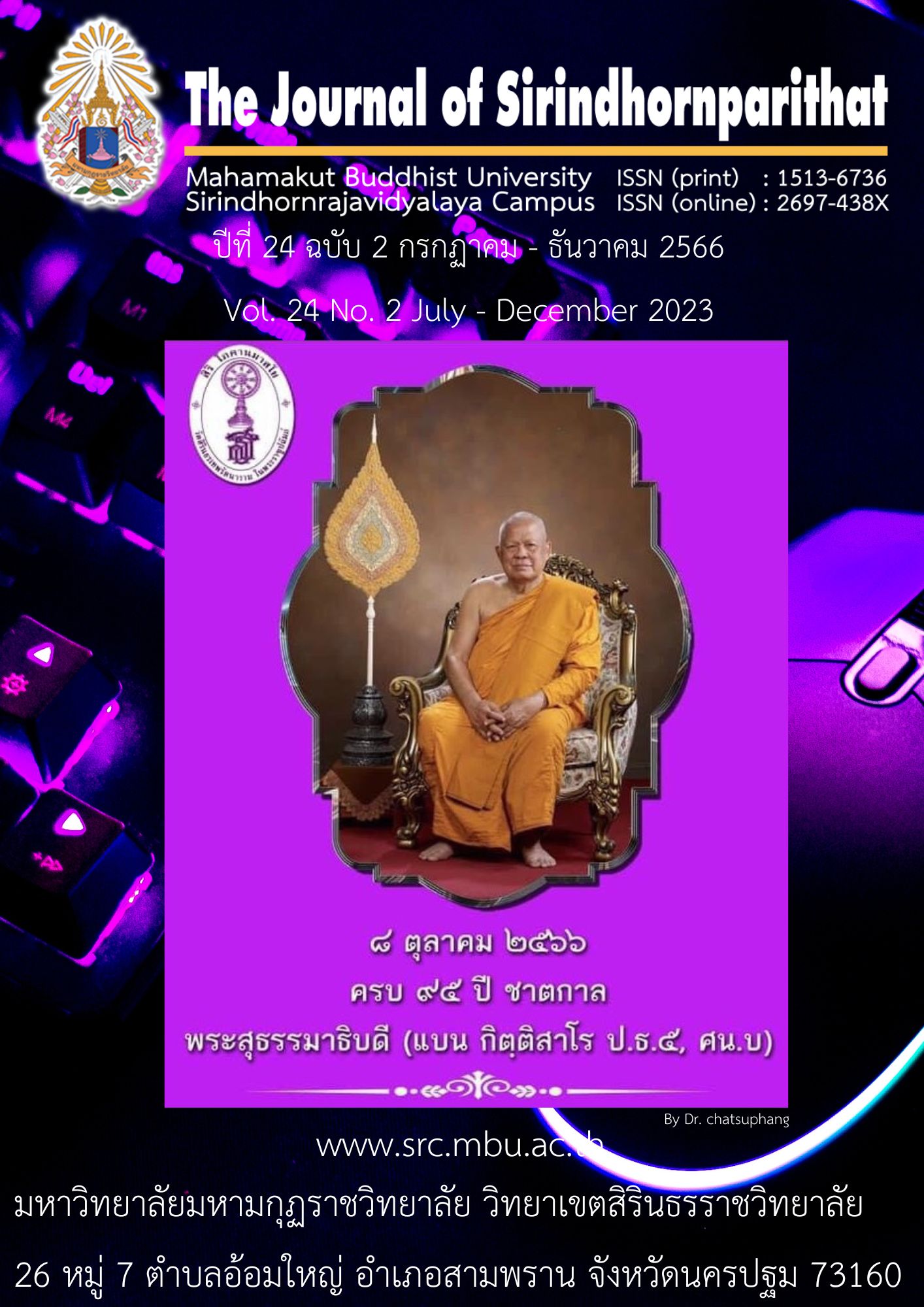Buddhist Studies for Building a Peaceful Society
Keywords:
Buddhist Studies, building a peaceful society, peaceAbstract
This research on Buddhist studies for building a peaceful society. It is a qualitative research, a field research with the following objectives: 1) To study the content and essences of studying in the Buddhist Studies Curriculum for Peaceful Society 2) To study the content and essences element of the Buddhist Studies Curriculum for Peaceful Society and 3) To present the creation of a peaceful society by studying the contents of the Buddhist Studies curriculum for creating a peaceful society. There were three groups of key informants used in research by in-depth interviews and experts in the focus group discussion: group 1, the faculty who gave lectures on Buddhism, group 2, the faculty who lectured on peace studies, MMR, and group 3, students who studied Buddhism at the graduate level, the total number of 17persons. The data analysis were descriptive content analysis.
The results showed that: 1. The content and essence of teaching Buddhist studies for the creation of a peaceful society found that there are teachings on morality, concentration, and wisdom, 2.The elements of content and essence of teaching Buddhist studies for the creation of a peaceful society found that there are elements of morality, concentration, and wisdom, there are good results of morality, good results of concentration, and good results of wisdom and keeping the precepts or observing the precepts, keeping the Meditation treatment or meditation practice, and Keeping Wisdom or Practicing Wisdom, and 3. Presenting of creating a peaceful society by studying the contents and essences of the Buddhist Studies for building a Peaceful Society. It found that if morality, concentration, and wisdom were actually implemented in any society, Peace that is not encroachment on one another's body and property, would come in that society.
References
กระทรวงศึกษาธิการ. (2562). หลักสูตรแกนกลางการศึกษาขั้นพื้นฐาน พุทธศักราช 2551 (ฉบับปรับปรุง 2561). กรุงเทพมหานคร. กระทรวงศึกษาธิการ.
กิตติศักดิ์ ลักษณา. (2554). “การพัฒนาหลักสูตรสันติศึกษาตามแนวคิดการเรียนรู้โดยเน้นทีม สำหรับนักเรียนระดับมัธยมศึกษาตอนปลาย”. ปริญญาการศึกษาดุษฎีบัณฑิต. สาขาวิชาการวิจัยและพัฒนาหลักสูตร. บัณฑิตวิทยาลัย. มหาวิทยาลัยศรีนครินทรวิโรฒ.
ชัยยศ อินทแสน. บรรจบ บรรณรุจิและขันทอง วัฒนะประดิษฐ์. (2560). “แนวทางการเสริมสร้างสังคมสันติสุขของมูลนิธิมิราเคิลออฟไลฟ์ตามหลักพุทธสันติวิธี”. วารสารสันติศึกษาปริทรรศน์ มจร. 5(2): 299-311.
พระไพศาล วิสาโล. (2546). พุทธศาสนาในอนาคต แนวโน้มและทางออกจากวิกฤต. กรุงเทพมหานคร. มูลนิธิสดศรี-สฤษดิ์วงศ์.
พระเมธาวินัยรส (สุเทพ ปสิวิโก). (2556). เอกสารประกอบการสอนรายวิชา : สัมมนาพระพุทธศาสนากับปัญหาสังคมโลกและสันติภาพ. นครปฐม. บัณฑิตวิทยาลัย มหาวิทยาลัยมหามกุฏราชวิทยาลัย.
สถาบันพระปกเกล้า. (2559). “สันติสุขเกิดได้ภายใต้ความแตกต่าง”. รายงานวิชาการ. นนทบุรี: สำนักสันติวิธีและธรรมมาภิบาล สถาบันพระปกเกล้า.
สมภาร พรมทา. (2548). พุทธปรัชญา : มนุษย์ สังคม และ ปัญหาจริยธรรม. พิมพ์ครั้งที่ 2. กรุงเทพมหานคร. ศยาม.
Norman K. Denzin. (2022). Introduction: Transformative Vision for Qualitative Inquiry. Lowa City: The University of Lowa.

Downloads
Published
Issue
Section
License
Copyright (c) 2023 Mahamakut Buddhist University

This work is licensed under a Creative Commons Attribution-NonCommercial-NoDerivatives 4.0 International License.
บทความที่ได้รับการตีพิมพ์เป็นลิขสิทธิ์ของ มหาวิทยาลัยมหามกุฏราชวิทยาลัย วิทยาเขตสิรินธรราชวิทยาลัย
ข้อความที่ปรากฏในบทความแต่ละเรื่องในวารสารวิชาการเล่มนี้เป็นความคิดเห็นส่วนตัวของผู้เขียนแต่ละท่านไม่เกี่ยวข้องกับหาวิทยาลัยมหามกุฏราชวิทยาลัย วิทยาเขตสิรินธรราชวิทยาลัย และคณาจารย์ท่านอื่นๆในมหาวิทยาลัยฯ แต่อย่างใด ความรับผิดชอบองค์ประกอบทั้งหมดของบทความแต่ละเรื่องเป็นของผู้เขียนแต่ละท่าน หากมีความผิดพลาดใดๆ ผู้เขียนแต่ละท่านจะรับผิดชอบบทความของตนเองแต่ผู้เดียว



